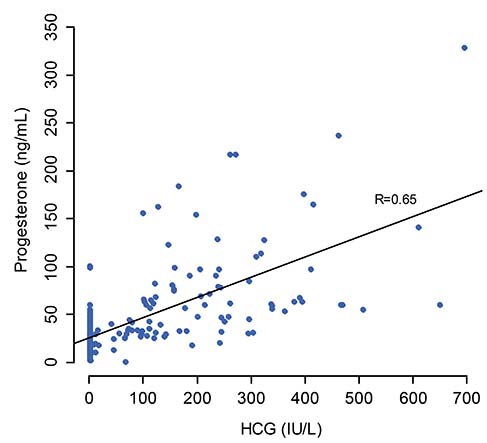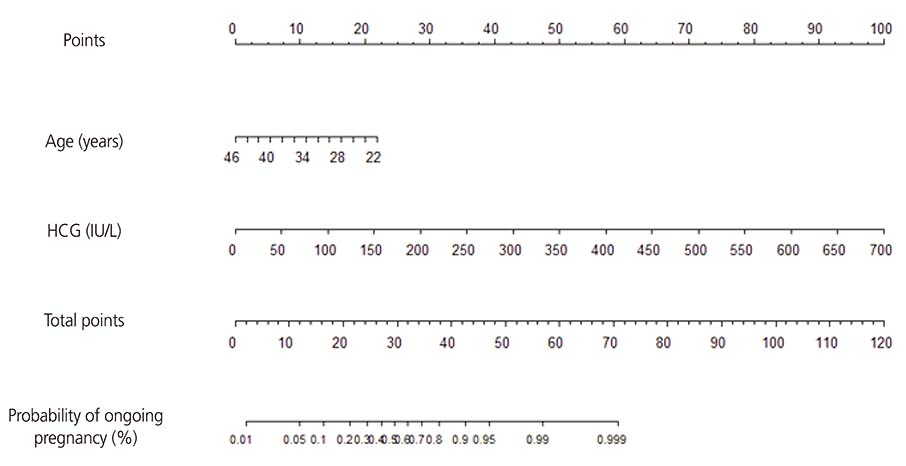Obstet Gynecol Sci.
2018 Nov;61(6):669-674. 10.5468/ogs.2018.61.6.669.
Development of a novel nomogram for predicting ongoing pregnancy after in vitro fertilization and embryo transfer
- Affiliations
-
- 1Department of Obstetrics and Gynecology, Seoul National University Bundang Hospital, Seongnam, Korea. blasto@snubh.org
- 2Department of Obstetrics and Gynecology, Seoul National University College of Medicine, Seoul, Korea.
- 3Department of Obstetrics and Gynecology, Seoul National University Hospital, Seoul, Korea.
- KMID: 2426010
- DOI: http://doi.org/10.5468/ogs.2018.61.6.669
Abstract
OBJECTIVE
This study aimed to develop a nomogram that predicts ongoing pregnancy after in vitro fertilization and embryo transfer (IVF-ET) using patient age and serum hormonal markers.
METHODS
A total of 284 IVF-ET cycles were retrospectively analyzed. At 14 days post-oocyte pick-up (OPU), the serum human chorionic gonadotropin (HCG) and progesterone levels were measured. The main predicted outcome was ongoing pregnancy.
RESULTS
Patient age and serum of HCG and progesterone levels at 14 days post-OPU were good predictors of ongoing pregnancy. The cut-off value and area under the curve (AUC) (95% confidence interval) were 36.5 years and 0.666 (0.599-0.733), respectively, for patient age; 67.8 mIU/mL and 0.969 (0.951-0.987), respectively, for serum HCG level; and 29.8 ng/mL and 0.883 (0.840-0.925), respectively, for serum progesterone level. When the prediction model was constructed using these three parameters, the addition of serum progesterone level to the prediction model did not increase its overall predictability. Furthermore, a high linear co-relationship was found between serum HCG and progesterone levels. Therefore, we developed a new nomogram using patient age and HCG serum level only. The AUC of the newly developed nomogram for predicting ongoing pregnancy after IVF-ET cycles using patient age and serum HCG level was as high as 0.975.
CONCLUSION
We showed that ongoing pregnancy may be predicted using only patient age and HCG serum level. Our nomogram could help clinicians and patients predict ongoing pregnancy after IVF-ET if the serum JCG level was ≥5 IU/L at 14 days post-OPU.
MeSH Terms
Figure
Reference
-
1. Turner K, Reynolds-May MF, Zitek EM, Tisdale RL, Carlisle AB, Westphal LM. Stress and anxiety scores in first and repeat IVF cycles: a pilot study. PLoS One. 2013; 8:e63743.
Article2. Kim JH, Shin MS, Yi G, Jee BC, Lee JR, Suh CS, et al. Serum biomarkers for predicting pregnancy outcome in women undergoing IVF: human chorionic gonadotropin, progesterone, and inhibin A level at 11 days post-ET. Clin Exp Reprod Med. 2012; 39:28–32.
Article3. Wang Q, Zhang R, Jia M, Luo L, Ding C, Li TC, et al. Serum human chorionic gonadotropin measured 7 days following day 3 embryo transfer might predict pregnancy outcome in IVF. Gynecol Endocrinol. 2017; 33:62–66.
Article4. Urbancsek J, Hauzman E, Fedorcsák P, Halmos A, Dévényi N, Papp Z. Serum human chorionic gonadotropin measurements may predict pregnancy outcome and multiple gestation after in vitro fertilization. Fertil Steril. 2002; 78:540–542.5. van Mello NM, Mol F, Opmeer BC, Ankum WM, Barnhart K, Coomarasamy A, et al. Diagnostic value of serum hCG on the outcome of pregnancy of unknown location: a systematic review and meta-analysis. Hum Reprod Update. 2012; 18:603–617.
Article6. Eastham JA, Kattan MW, Scardino PT. Nomograms as predictive models. Semin Urol Oncol. 2002; 20:108–115.
Article7. Kim JH, Jee BC, Suh CS, Kim SH. Nomogram to predict ongoing pregnancy using age of women and serum biomarkers after in vitro fertilization cycles. Eur J Obstet Gynecol Reprod Biol. 2014; 172:65–69.8. Tulchinsky D, Hobel CJ. Plasma human chorionic gonadotropin, estrone, estradiol, estriol, progesterone, and 17 α-hydroxyprogesterone in human pregnancy. 3. Early normal pregnancy. Am J Obstet Gynecol. 1973; 117:884–893.9. van Kooij RJ, Looman CW, Habbema JD, Dorland M, te Velde ER. Age-dependent decrease in embryo implantation rate after in vitro fertilization. Fertil Steril. 1996; 66:769–775.10. Arck P, Hansen PJ, Mulac Jericevic B, Piccinni MP, Szekeres-Bartho J. Progesterone during pregnancy: endocrine-immune cross talk in mammalian species and the role of stress. Am J Reprod Immunol. 2007; 58:268–279.
Article
- Full Text Links
- Actions
-
Cited
- CITED
-
- Close
- Share
- Similar articles
-
- A Case of Primary Ovarian Pregnancy after In Vitro Fertilization and Embryo Transfer
- A Case of Combined Interstitial and Intrauterine Pregnancy as Fifth Ectopic Pregnancies after In Vitro Fertilization and Embryo Transfer in Bilateral Salpingectomy patient
- Combined intrauterine and intraligamentary full term pregnancy after in vitro fertilization & embryo transfer
- A case of heterotopic pregnancy following in vitro fertilization and embryo transfer
- A case of Heterotopic Pregnancy following in vitro fertilization: transcervical evacuation with preserved intrauterine pregnancy



